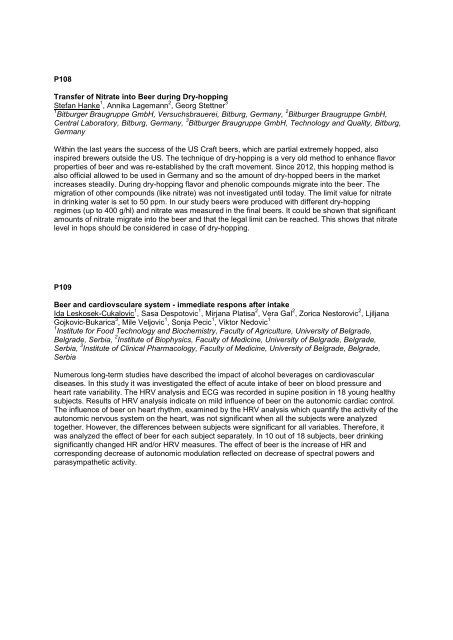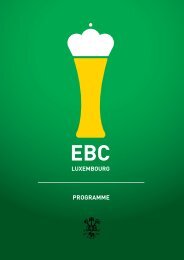here - the 34th European Brewery Convention
here - the 34th European Brewery Convention
here - the 34th European Brewery Convention
Create successful ePaper yourself
Turn your PDF publications into a flip-book with our unique Google optimized e-Paper software.
P108<br />
Transfer of Nitrate into Beer during Dry-hopping<br />
Stefan Hanke 1 , Annika Lagemann 2 , Georg Stettner 3<br />
1 Bitburger Braugruppe GmbH, Versuchsbrauerei, Bitburg, Germany, 2 Bitburger Braugruppe GmbH,<br />
Central Laboratory, Bitburg, Germany, 3 Bitburger Braugruppe GmbH, Technology and Quality, Bitburg,<br />
Germany<br />
Within <strong>the</strong> last years <strong>the</strong> success of <strong>the</strong> US Craft beers, which are partial extremely hopped, also<br />
inspired brewers outside <strong>the</strong> US. The technique of dry-hopping is a very old method to enhance flavor<br />
properties of beer and was re-established by <strong>the</strong> craft movement. Since 2012, this hopping method is<br />
also official allowed to be used in Germany and so <strong>the</strong> amount of dry-hopped beers in <strong>the</strong> market<br />
increases steadily. During dry-hopping flavor and phenolic compounds migrate into <strong>the</strong> beer. The<br />
migration of o<strong>the</strong>r compounds (like nitrate) was not investigated until today. The limit value for nitrate<br />
in drinking water is set to 50 ppm. In our study beers were produced with different dry-hopping<br />
regimes (up to 400 g/hl) and nitrate was measured in <strong>the</strong> final beers. It could be shown that significant<br />
amounts of nitrate migrate into <strong>the</strong> beer and that <strong>the</strong> legal limit can be reached. This shows that nitrate<br />
level in hops should be considered in case of dry-hopping.<br />
P109<br />
Beer and cardiovsculare system - immediate respons after intake<br />
Ida Leskosek-Cukalovic 1 , Sasa Despotovic 1 , Mirjana Platisa 2 , Vera Gal 2 , Zorica Nestorovic 2 , Ljiljana<br />
Gojkovic-Bukarica 3 , Mile Veljovic 1 , Sonja Pecic 1 , Viktor Nedovic 1<br />
1 Institute for Food Technology and Biochemistry, Faculty of Agriculture, University of Belgrade,<br />
Belgrade, Serbia, 2 Institute of Biophysics, Faculty of Medicine, University of Belgrade, Belgrade,<br />
Serbia, 3 Institute of Clinical Pharmacology, Faculty of Medicine, University of Belgrade, Belgrade,<br />
Serbia<br />
Numerous long-term studies have described <strong>the</strong> impact of alcohol beverages on cardiovascular<br />
diseases. In this study it was investigated <strong>the</strong> effect of acute intake of beer on blood pressure and<br />
heart rate variability. The HRV analysis and ECG was recorded in supine position in 18 young healthy<br />
subjects. Results of HRV analysis indicate on mild influence of beer on <strong>the</strong> autonomic cardiac control.<br />
The influence of beer on heart rhythm, examined by <strong>the</strong> HRV analysis which quantify <strong>the</strong> activity of <strong>the</strong><br />
autonomic nervous system on <strong>the</strong> heart, was not significant when all <strong>the</strong> subjects were analyzed<br />
toge<strong>the</strong>r. However, <strong>the</strong> differences between subjects were significant for all variables. T<strong>here</strong>fore, it<br />
was analyzed <strong>the</strong> effect of beer for each subject separately. In 10 out of 18 subjects, beer drinking<br />
significantly changed HR and/or HRV measures. The effect of beer is <strong>the</strong> increase of HR and<br />
corresponding decrease of autonomic modulation reflected on decrease of spectral powers and<br />
parasympa<strong>the</strong>tic activity.





